Tuesday we set out for St. Simons Island, one of the barrier islands situated off the Georgia coast making up the Golden Isles. The narrow driveway in front of the visitor's center had large, old oaks on either side. Russ said he was glad he didn't have to bring the RV down it because of the low hanging branches. You can see just how low in this photo of Russ touching the bot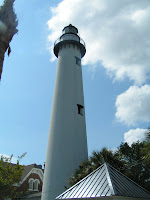 tom of one of the limbs while standing in the drive! Next to the visitor's center is the 104 foot tall St. Simons Lighthouse, which was completed in 1872 and is one of only five that exist in GA. It is still a working lighthouse operated by the U.S. Coast Guard, but its maintenance and preservation are handled by the Coastal GA Historical Society. Russ and I climbed the 129 steps to the top, but Scott decided to wait downstairs in the lightkeepers home/m
tom of one of the limbs while standing in the drive! Next to the visitor's center is the 104 foot tall St. Simons Lighthouse, which was completed in 1872 and is one of only five that exist in GA. It is still a working lighthouse operated by the U.S. Coast Guard, but its maintenance and preservation are handled by the Coastal GA Historical Society. Russ and I climbed the 129 steps to the top, but Scott decided to wait downstairs in the lightkeepers home/m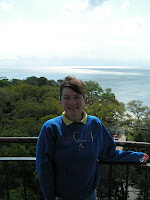 useum. It was quite windy up there, but the view was incredible.
useum. It was quite windy up there, but the view was incredible.
From there we drove down the road a piece to the Maritime Museum, which is listed on the National Register of Historic Places, and was a Coast Guard Station during Roosevelt's time. Inside is a pictoral history of the station and the surrounding GA coast and tells of its importance during WWII. Did you know that several ships were sunk off the GA coast? I never remembered learning that the war was that close to the U.S. other than on Pearl Harbor. And did you know that the coast of GA is only 100 miles long, yet its one-half million acres of salt marsh constitute nearly 1/3 of all the salt marshes of the Eastern Atlantic states?
This road was actually taking us to Fort Federica National Monument, which had been established back in 1736 by Gen. James Oglethorpe to protect English interests from Spanish forces. The Fort, currently run by the National Pa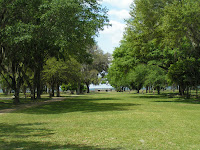 rk Service, was originally designed in the traditional European pattern of a square structure surrounded by a three-diamond shaped fortress and behind it was the town of Fort Federica. Now all that remains of the town are ruins, mainly outlines of the structures that once stood. However part of the fort still stands, complete with a British flag flying. The picture on the right actually shows what at the time was the main road through town leading to the Fort called Broad Street, which actually divided the town into north and south wards, and was 75 feet wide and lined with orange trees. There are actually still some orange trees ripe with fruit on the grounds. Unfortunately, with the onset of peace, Frederica soon became a ghost town. It had outlived its purpose and fell into ruin.
rk Service, was originally designed in the traditional European pattern of a square structure surrounded by a three-diamond shaped fortress and behind it was the town of Fort Federica. Now all that remains of the town are ruins, mainly outlines of the structures that once stood. However part of the fort still stands, complete with a British flag flying. The picture on the right actually shows what at the time was the main road through town leading to the Fort called Broad Street, which actually divided the town into north and south wards, and was 75 feet wide and lined with orange trees. There are actually still some orange trees ripe with fruit on the grounds. Unfortunately, with the onset of peace, Frederica soon became a ghost town. It had outlived its purpose and fell into ruin.
On the drive back we passed by Christ Church, which is the 3rd oldest church in GA, and still holds weekly services open to the public. It was built on the site where John and Charles Wesley (the fathers of the Metho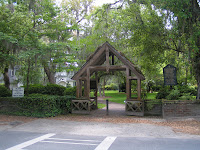 dist Church) held services under the oak trees near the location of the present church. The original church was destroyed by Union troops during the Civil War, but in 1884 Anson Phelps Dodge built the present day structure in memory of his wife.
dist Church) held services under the oak trees near the location of the present church. The original church was destroyed by Union troops during the Civil War, but in 1884 Anson Phelps Dodge built the present day structure in memory of his wife.
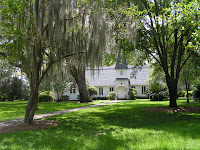
Russ had heard that this was Tax Tuesday at McDonald's meaning that when you bought one Big Mac, you got the 2nd one for a penny! So of course, that's where we stopped for lunch on the way back.

No comments:
Post a Comment